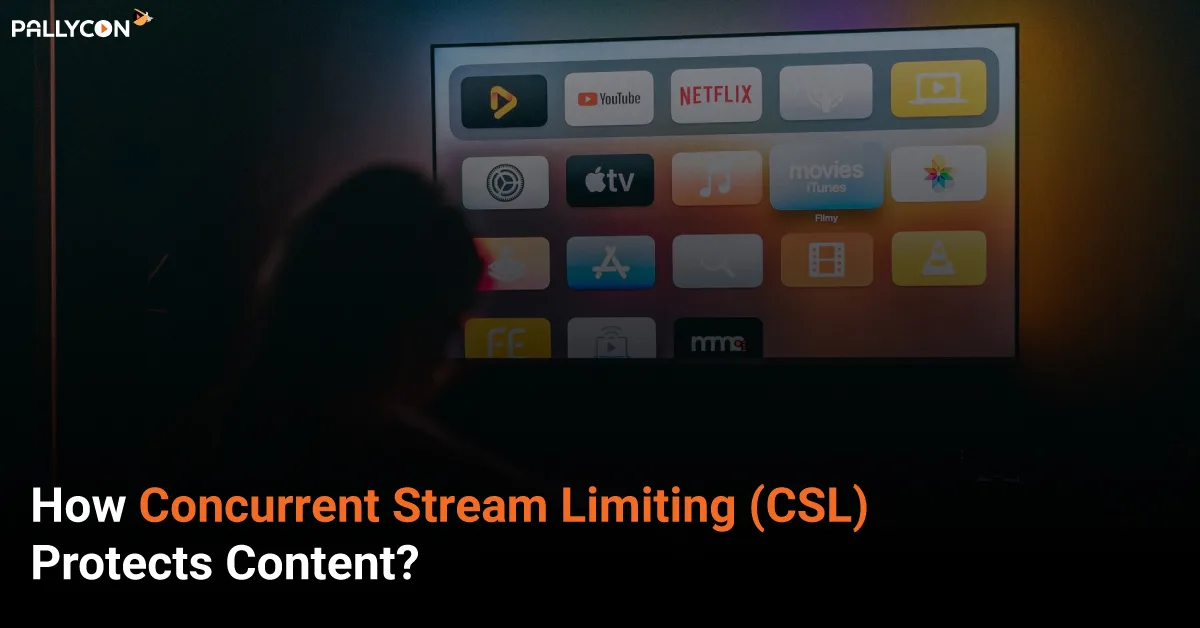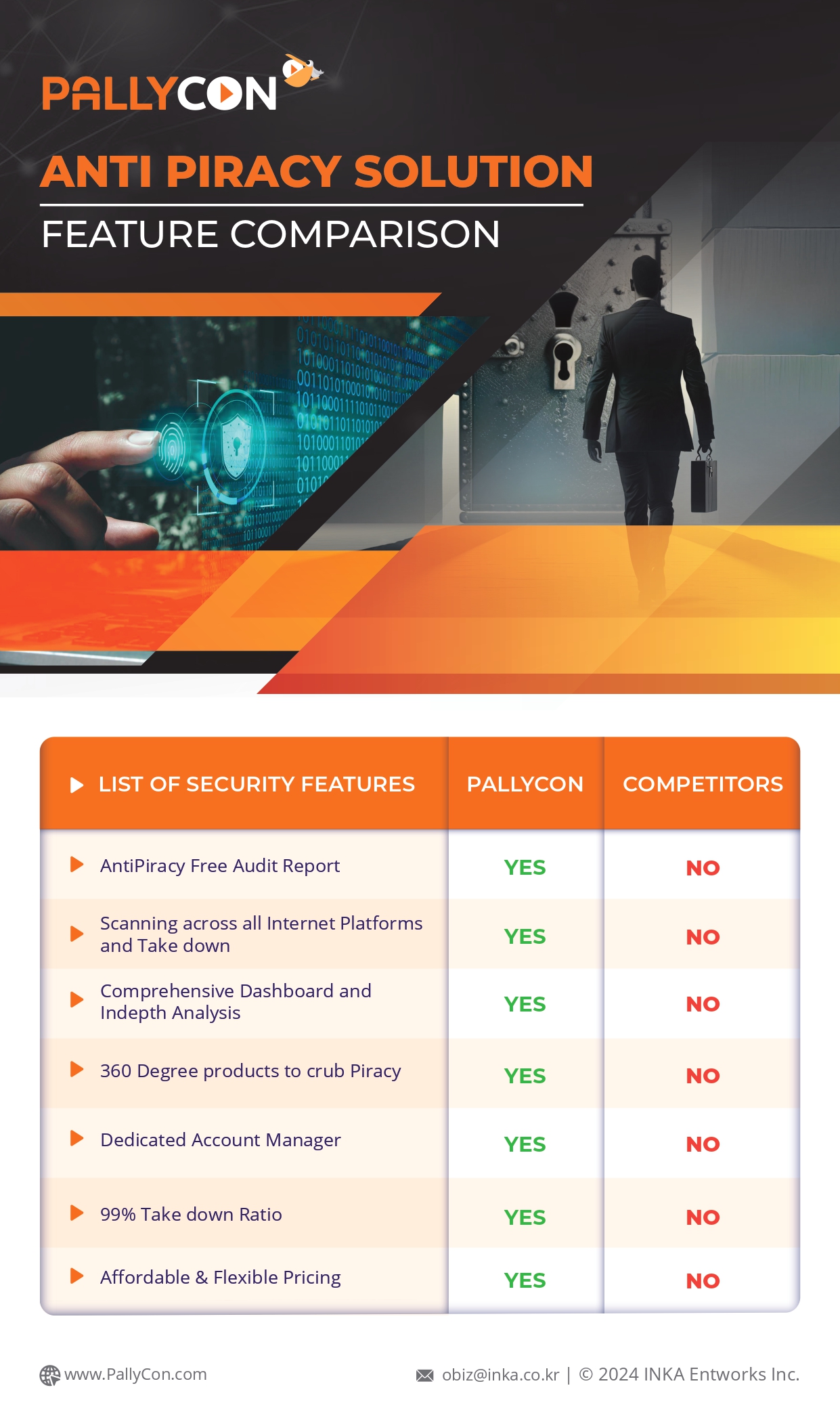
How Concurrent Stream Limiting (CSL) Protects Content?
As more media organizations adopt streaming, concurrent stream limiting (CSL) has become a critical component of their digital rights management (DRM) strategy, serving as a frontline defense in protecting intellectual property (IP).
The challenge of unauthorized sharing has grown increasingly over the last few years, leading to significant revenue losses for content providers. In 2022 alone, U.S. streaming services lost over $2.3 billion due to password sharing, with Netflix losing the highest amount at $791 million. This growing challenge makes CSL a key strategy for preventing unauthorized access and protecting content value.
By implementing concurrent stream limits, organizations can protect their valuable content while ensuring a fair experience for their customers. This delicate balance between security and user satisfaction makes CSL an essential cornerstone of modern DRM strategies.
What is Concurrent Stream Limiting?
Streaming services have responded to widespread password sharing by implementing CSL, a system that monitors and limits simultaneous content access. After Netflix cracked down on password sharing, paid subscriber accounts grew by 16.5%. And other streaming services, such as Disney+, have followed suit, making streaming more profitable than ever. These services typically offer tiered subscription models with varying concurrent stream limits — from basic plans allowing single-stream access to premium options supporting multiple simultaneous viewers.
At its core, CSL is a technological framework that monitors and controls simultaneous access to digital content from multiple devices or locations using a single set of credentials. The technology operates by combining session management and user authentication systems. When a user initiates a stream, the system generates unique session tokens and monitors various parameters, including IP addresses, device identifiers, and geographical location data. These elements work in concert to maintain an accurate count of active streams and enforce predetermined limits.
How CSL Works in Practice?
Consider a user who begins streaming content on one device, initiating a session tracked by the DRM server. If the user starts another stream on a second device, the system increases the concurrent stream count. However, when a third device attempts to play content, the server blocks the request and displays a message explaining the limit. Once the first device stops streaming and the license expires after the renewal cycle, the count decreases, allowing the third device to start streaming.
This process ensures that access limits are enforced in real-time while maintaining a seamless user experience. The customers learn their limits through clear messaging, reducing frustration and enhancing transparency.
The Role of AI in Modern CSL
Modern concurrent stream limiting increasingly incorporates artificial intelligence and machine learning algorithms to enhance their capabilities. These advanced technologies enable:
- Real-time pattern analysis to detect suspicious access patterns
- Predictive modeling to identify potential abuse before it occurs
- Dynamic adjustment of access controls based on user behavior
- Automated risk scoring for unusual streaming activities
Establishing a concurrent stream limit helps prevent password sharing and boosts streaming revenue, making it a critical component of digital rights management.
How CSL Benefits Digital Rights Management?
Within the broader DRM ecosystem, concurrent stream limiting ensures content protection and monetization. By enforcing rules and restrictions on how digital content is accessed, DRM guarantees that creators, publishers, and distributors can maintain control over how customers access their work, safeguarding both revenue streams and creative rights across media types like movies, music, e-books, and video games.
The implementation of CSL delivers several key benefits to content providers:
Enhanced Security and Compliance
CSL strengthens overall content protection by creating a framework for access control. It allows organizations to comply with licensing agreements while providing clear audit trails of content access and usage patterns, demonstrating due diligence in protecting their IP.
Revenue Protection
CSL helps organizations protect their revenue streams by preventing unauthorized account sharing and access. The technology enables content providers to maintain the value of their subscription models by ensuring that each paying customer operates within their licensed limits.
Improved User Experience
When implemented thoughtfully, CSL can enhance the legitimate user experience. By preventing system overload from unauthorized access, content providers can ensure their paying customers receive consistent service quality. Clear stream limits also help users better understand and manage their subscription benefits.
While these benefits make CSL an attractive solution for content providers, implementing and maintaining an effective concurrent stream-limiting system comes with its own set of complex challenges.
3 Key Challenges in Concurrent Stream Limits
As streaming platforms and digital content delivery systems become more sophisticated, the complexity of implementing and maintaining effective concurrent stream limits increases proportionally. Organizations must navigate a landscape where users expect seamless experiences across multiple devices and locations while sophisticated bad actors continuously develop new methods to circumvent access controls. This tension between security and accessibility creates unique hurdles that require careful consideration and ongoing adaptation.
Implementing CSL must account for use cases such as family members streaming from different locations, temporary network disruptions, and varying device capabilities — all while maintaining robust security measures. Additionally, organizations must consider regional differences in streaming behavior, varying internet infrastructure quality, and evolving regulatory requirements around data privacy and user rights.
These challenges typically manifest in three critical areas:
Complex User Authentication
Accurately identifying legitimate users while blocking unauthorized access requires sophisticated authentication mechanisms. Organizations must balance security requirements with user convenience, particularly when managing access across diverse device ecosystems and varying network conditions.
Technical Scalability
CSL implementation requires a robust technical infrastructure capable of handling real-time session monitoring and enforcement across potentially millions of concurrent users. This infrastructure should maintain high availability while processing complex authentication and authorization decisions within milliseconds.
User Education
Managing exceptional situations — such as temporary network disruptions or legitimate travel scenarios — requires careful consideration. Organizations must develop clear policies and educational materials to help users understand stream limits and troubleshoot common issues.
To address these challenges, some content service providers have explored alternative methods for managing account sharing and enforcing access controls.
Exploring Alternatives to CSL for Content Protection
While CSL is an effective tool, content service providers have used other methods to curb excessive account sharing, each with their own advantages and limitations.
Limiting the Number of Registered Devices
One approach involves restricting the number of devices registered to a single user account based on unique device identifiers. However, this method has drawbacks:
-
Privacy concerns and restrictions :
Obtaining unique device identifiers is increasingly difficult due to browser and mobile app restrictions, and it could violate data privacy regulations, depending on your location.
-
Administrative complexity and security :
Users need to be able to register and deregister devices, which can introduce security vulnerabilities if exploited.
Application-Level Concurrent Stream Management
Another method tracks playback start and end times at the application level, relying on backend communication rather than DRM enforcement. But this, too, has its challenges:
-
Security risks :
Hackers can manipulate the client-side logic to bypass restrictions.
-
Inaccurate stream counts :
If an application crashes unexpectedly, the system may fail to register the stream’s end, leading to inaccurate enforcement.
By contrast, CSL implemented through DRM renewal cycles avoids these challenges, offering a more secure and automated approach to enforcing stream limits.
By understanding the strengths and weaknesses of these alternative approaches, organizations can make informed decisions about whether implementing a concurrent stream limit is the best fit for their needs or should be combined with other security measures. If they decide to use CSL, they must understand how to configure it to work for their organization.
How to Use Concurrent Stream Limiting?
Effective configuration can help strike the right balance between security and usability within a concurrent stream-limiting system. By carefully defining concurrent stream limit parameters, organizations can enforce content access rules while minimizing disruptions for legitimate subscribers. Here are two areas to keep top of mind:
-
Configuring CSL Parameters
Organizations using CSL can define key parameters, such as the maximum number of concurrent streams allowed per user account and the DRM license renewal cycle. These settings provide flexibility to align CSL functionality with business needs. For instance, a platform might allow two concurrent streams per account and set a license renewal interval of 10 minutes to verify active sessions regularly.
-
Customizing for Different Scenarios
CSL settings can be adjusted to accommodate varying user needs. For example, premium subscription tiers may allow more simultaneous streams, while basic plans might limit access to one device. Additionally, shorter renewal cycles can tighten security by quickly identifying unauthorized use, while longer cycles offer more leniency for legitimate users.
By leveraging these two customizable features, content providers can optimize CSL to strike the right balance between protecting IP and delivering a smooth, user-friendly experience.
Protecting Digital Content in an Evolving Landscape
As streaming services continue to evolve, concurrent stream limiting (CSL) remains a powerful tool for protecting digital content, preserving revenue, and ensuring compliance with licensing agreements.
While CSL can have its challenges, its benefits in security, revenue protection, and user satisfaction make it an essential component of modern digital rights management strategies. By understanding the strengths of CSL and how best to implement it, organizations can develop comprehensive approaches to secure their content while delivering a high-quality experience to its customers.
FAQs on Concurrent Stream Limit
Is there any difference between CSL and device authentication?
While device authentication verifies the device logging into an account, CSL controls the number of simultaneous streaming by preventing multiple users from accessing content on different devices simultaneously using the same credentials.
Why is Concurrent Stream Limiting important for DRM?
CSL protects DRM by enforcing streaming limits that prevent unauthorized account sharing. This safeguards revenue streams and ensures compliance with licensing agreements while maintaining the value of subscription-based content.
What role does CSL play in live streaming?
In live streaming, such as live sports or concerts, CSL ensures that only authorized users can access premium events simultaneously, protecting exclusive content and preventing unauthorized restreaming.
How does CSL handle multiple user profiles under a single account?
CSL can differentiate between user profiles but limits the total number of streams on one account. For example, a family account might allow four simultaneous streams, regardless of which profiles are in use, ensuring fair usage while preventing account sharing outside the household.
Can CSL adapt to changing user behavior, like travel or temporary network changes?
Modern CSL systems use AI to adjust access rules automatically. For example, they can let users watch from different regions while on vacation or notice network issues without wrongly locking the account.
Daniel is a DRM specialist and has been associated with this industry for over 10 years. Other than this, he is addicted to reading and writing.
